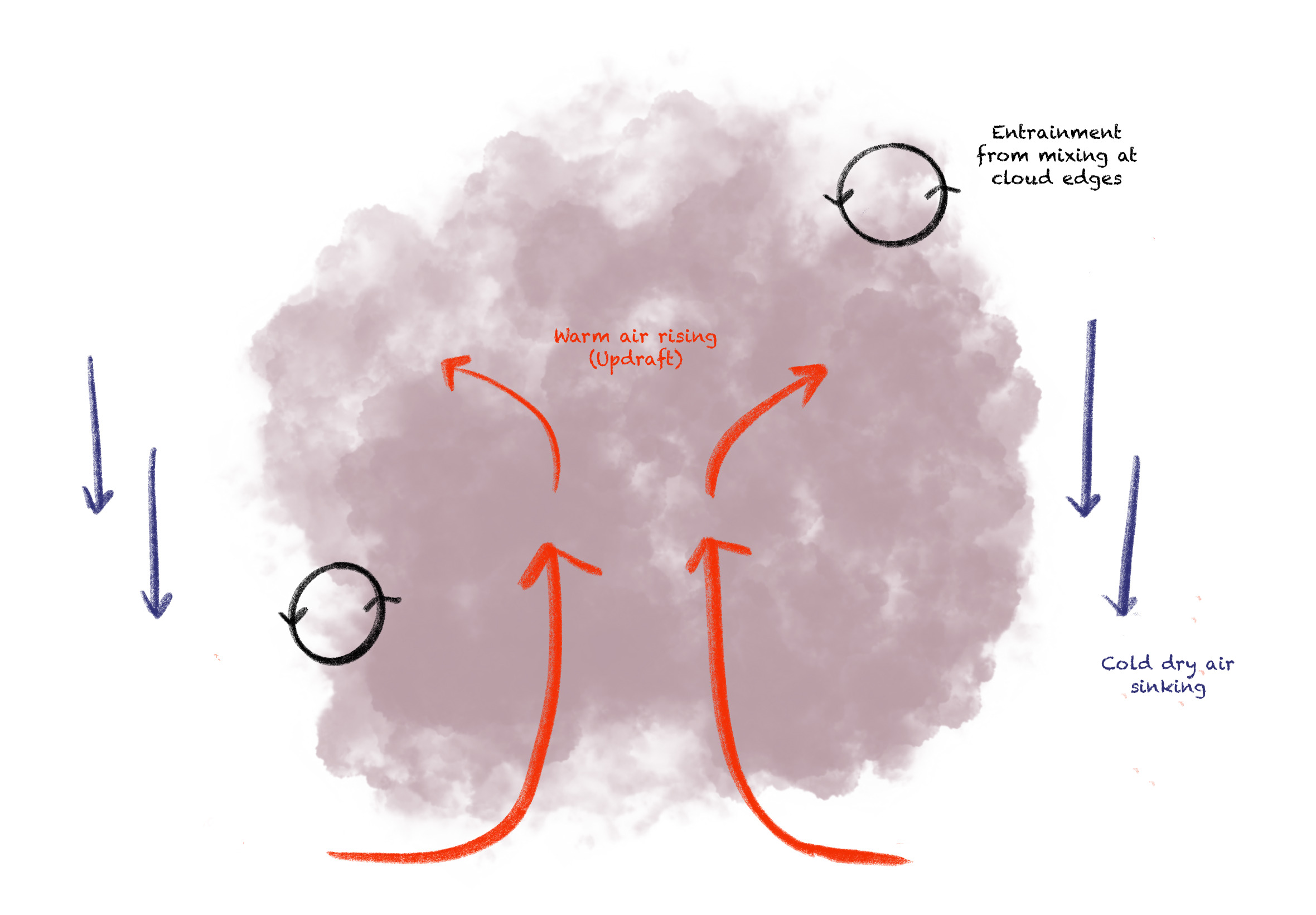Little Particles. Big Storms.
Scientists can’t agree upon the role of aerosols on clouds that affect severe weather. Why does it matter?

Democrats and Republicans disagree on the reality of real climate change. The scientific equivalent, albeit less fiery or politically driven, is a raging debate among cloud physicists on the impact of aerosols on severe weather-causing clouds. But unlike the political divide, this one doesn't have a clear winner. This means that we will continue to be unsure of the human influence on storms that cost lives and cause considerable damage to property.
Aerosols are defined as any solid or liquid particle suspended in a gaseous medium. Simply put, these are tiny particles floating all around us and within the Earth’s atmosphere. Aerosols can be emitted into the atmosphere naturally, like volcanic soot or through anthropogenic (human-driven) sources like automotive or industrial pollution. Among other things, they impact how clouds form. Different aerosols impact climate and clouds differently.
The launch of NASA’s Plankton, Aerosol, Cloud Ocean Ecosystem (PACE) mission on February 8 2024, aims to collect data on tiny particles like aerosols and planktons to address some of the uncertainties climate scientists have identified in current climate models.
Aerosols are currently a big headache for climate scientists. There is a general agreement that they are a major source of uncertainty in climate models and limit our understanding of climate change. But this problem itself is divided into different slivers of issues.
One such issue concerns the impact of aerosols on big, bad clouds that are responsible for billion dollar storms. Scientists call these clouds ‘deep convective clouds’. Aerosols and clouds are often studied by taking instrument-laden aircrafts into the atmosphere. But, not all storms are created equal, and deep convective clouds are bigger and mightier than what an aircraft can safely venture into. This makes direct data collection a near impossible task.
Severe weather events are getting more common with climate change. While some scientists think aerosols make these clouds a lot more powerful, others think the impact is negligible.
“There are many variables that dictate the strength and longevity of storm clouds. While we understand the theoretical dependence of storm clouds on the surrounding air (meteorological influences) and aerosols, we don’t quite understand how aerosols, clouds, and meteorology interact with each other. We have a hard time isolating the effects of aerosols and meteorology on cloud properties. Think of it as a nature versus nurture problem since clouds in turn affect both aerosols and the air around them. So we may be venturing into unknown disasters if we keep polluting. Unknown disasters means unknown mitigation or adaptation plans. If you don't know storms will be more frequent and stronger in the future, we won't plan for it. We don't know what we don't know”, says Siddhant Gupta, an Atmospheric Scientist at Argonne National Laboratory.
How do aerosols impact cloud formation?
To understand what this debate is about, it is important to understand how aerosols impact cloud formation in the first place. Water vapor turns to cloud droplets when an air mass reaches a condition called ‘supersaturation’. Depending on the air pressure, temperature, and moisture content, when the air has Relative Humidity greater than 100%, it can essentially no longer hold any more water vapor. This water vapor condenses on the surface of aerosols which act like a nucleus to form cloud droplets. Among other sources, aerosols also affect the degree of ‘supersaturation’. Under polluted conditions, i.e. when there are too many aerosols, they can “compete” to act as the nucleus (some aerosols are water-loving, or hydrophilic). Thus, the bar to reach the supersaturation values needed for cloud formation could be lowered.
What do aerosols do to storms?

What is highly debated today is whether air pollution makes clouds more energetic or ‘invigorated’. This low-key battle has intensified in recent years. For instance, in 2008, the publication of a paper by Rosenfeld et al (2008) laid a leading hypothesis for the ‘cold-phase’ invigoration of deep convective clouds, a term which can rile up the small community of scientists working in this field.
When water vapor condenses to form cloud droplets, the phase change from gas to liquid releases energy in the form of ‘latent heat’. As more numerous cloud droplets are formed under pollution conditions, the amount of ‘latent heat’ released increases. This causes the air inside the cloud to become warmer. Since warm air is less dense than cold air, it rises and can intensify the upward motion of air within the core of a cloud. This air inside the cloud that propels it upwards is called an ‘updraft’. The ‘warm-phase' invigoration hypothesis says that aerosols will make these updrafts stronger. This, in turn makes clouds last longer and potentially makes the resulting precipitation, hail, or lightning more intense.
The ‘cold-phase’ hypothesis mentioned earlier can be thought of as the downstream effect of greater cloud droplet formation in polluted conditions. Aerosols result in more cloud droplets in the updraft and as these droplets rise up within strong updrafts, they release latent heat as the droplets freeze to form ice crystals or snow Once again, this strengthens or invigorates the core of the cloud, causing its engine to run faster, and the cloud rises up higher, creating more intense precipitation, hail, or lightning.
There is a third hypothesis based on the concept called ‘entrainment’. Put simply, the air inside the cloud mixes with outside air and aerosols can influence this mixing process. Polluted conditions can result in increased environmental humidity by producing clouds that mix more condensed water into the surrounding air. This invigorates the aforementioned updrafts.
So what are scientists fighting about?
There is little agreement among scientists on whether these hypotheses are as potent as their proponents argue There is no dearth of multiplicity of so-called evidence for or against. But much of it is not observational. These clouds and their updrafts are usually not directly observed due to safety reasons. As mentioned above, aircrafts can struggle to stay in one place due to the physical risks. Thus, proxies are used.
Much of the literature is based on model simulations, a process by which theories are tested by simulating data and seeing if the theory can sustain the data simulated. But theories themselves are gross simplifications of the real world. Most of the in-fighting among scientists is a result of disagreement on assumptions and attributions to alternative phenomena that could be resulting in the observed updraft.
For example, in the case of the ‘warm-phase’ invigoration hypothesis, two studies contradict each other based on the criteria used to sort updraft speeds into categories based on air pollution. Enough research has now been accumulated that a research paper last year aimed to summarize the current state of the research while imploring scientists to define a new way forward to advance this area of research.
Wait, why does any of this matter?
Updrafts are the engines of thunderstorms. The National Oceanic and Atmospheric Administration (NOAA) explains that updrafts pull in moisture from the surrounding atmosphere, which is the fuel for storms. A stronger updraft can do this better, resulting in stronger thunderstorms and larger hail.
These theories, if true, could mean that man-made pollution is making severe weather events stronger or turn previously mild weather events into severe weather. This is not just your regular heavy rain, it is all the things that make for billion dollar storms, the ones which cause considerable impact on life and property. Even if we look at a subset of severe weather disasters that could be attributed to ‘deep convective’ clouds, there were over nineteen severe storms in 2023, that collectively cost the government $ 54 billion dollars. This is an understatement of the full impact of these clouds.
And where do we go from here?
NASA has selected a new Earth science mission that will study the behavior of tropical storms and thunderstorms, including their impacts on weather and climate models. Three cloud radars mounted on spacecrafts will monitor the vertical profile of deep convective clouds multiple times within a couple of minutes. Scientists intend to use the information gained from these profiles to create a global database of updraft strengths. This database combined with observations of aerosols and meteorology around these clouds is expected to help address the debate surrounding aerosol invigoration hypotheses.
This may finally put an end to the great aerosol battle of 2008.